Battle of Hyperstar
The last 3 years on the long-established satellite communications market one can observe a decent HYIP around low-orbit satellite (LEO) satellite hyperswitches projects - telecommunication systems consisting of many thousands of satellites, expensive and ambitious projects. It seems to me interesting to delve into the technical and economic details of these projects and talk about their prospects.
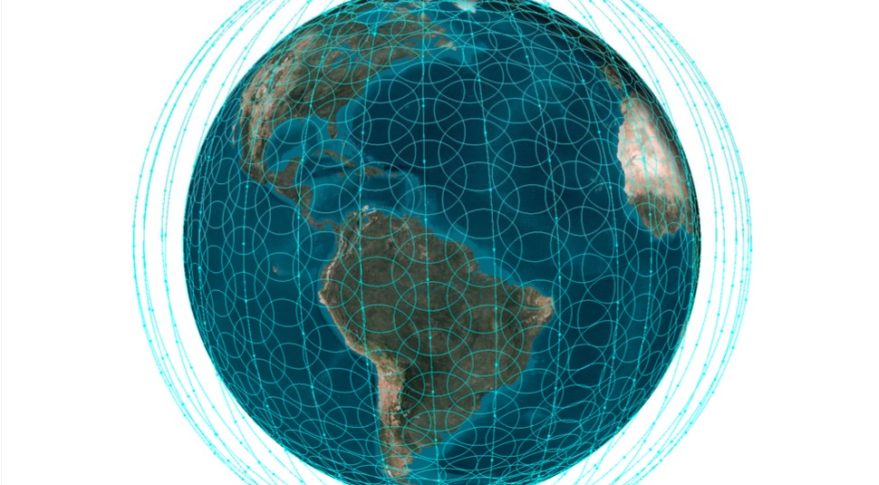
Satellite communications today and the last 30 years are primarily geostationary transponder satellites located, respectively, in a geostationary orbit, where the satellite is approximately fixed relative to a ground-based observer and is equivalent to a conventional radio repeater located on a 35,000-kilometer tower. At the same time, one single satellite is visible immediately from ~ 35% of the Earth’s area, and three are enough to cover the entire surface except the polar regions.
Geostationary communications satellites today are very heavy machines, weighing up to 4 tons (in working orbit) providing communication channels up to several hundred gigabits wide. This image of these satellites was formed, on the one hand, from a huge area of light by a radio signal from a satellite (how many radio towers can boast access to 5 billion potential customers?), And on the other hand - the weight of equipment that can squeeze the maximum bandwidth from an available radio spectrum.
')

Adjusting the antenna patterns of the geostationary satellite Eutelsat 8 West B. Pay attention to the “wrinkled” surfaces of the antenna reflectors - this is done specifically to form a contour pattern on Earth (hence the adjustment is required) and not to get into the outlines of other GSO satellites . Coordination of spatial-spectral characteristics is today a very difficult task in satellite projects, and low-orbit systems are no exception.
Pay attention to the words “available radio spectrum”. Satellite communications operate at frequencies from 1.5 to 60 gigahertz, however, in this very broad radio channel, there are not so many satellites available. Firstly, in the range from 1.5 to 10 GHz, many terrestrial consumers of the radio spectrum - a typical example - is wi-fi around central 2.4 and 5.5 GHz. Secondly, above 20 GHz, rain, hail, and cloudiness begin to affect the work of the radio channel. Thirdly, the available band has to be divided by at least two in order to organize the Earth-to-Satellite channel. As a result, the actively used satellite communications ranges (denoted by the letters S, C, Ku, Ka) are just 6 GHz of band, for which there is a deadly battle of many operators.
Initially, however, 6 GHz was quite enough. After all, 15 years ago, the main content that was delivered to subscribers of communications satellites was television, and the same radio signal could deliver TV content to tens of millions of subscribers at once. However, with the advent of 2000s, the market began to roll more and more toward digital two-way communication, where the need for bandwidth grows linearly with the number of subscribers.

Build a navigation satellite Galileo. In fact, the assembly of modern satellites is reduced to the manual installation of the components of the satellite systems on the power panels and the manual tracing of dozens of cables and pipelines that connect them, as well as to the large volume of functional tests of the resulting complex. In this regard, satellites are more like precision industrial equipment than, say, aircraft.
GSO satellites responded to the change in the market by spatial reuse of frequencies - the satellite emits a plurality of relatively narrow rays that come across the same frequencies (according to the principle of cellular networks). But this shift in needs has also shifted the optimality of the GSO machines towards other solutions.
From the high-flying GSO satellites we move on to the low-orbit satellite. The idea is to replace one heavy quasi-fixed satellite with a swarm of flying in a low orbit. The idea is rather obvious, but not used until the 90s, due to the balance of pro and contra.
What are the advantages of low-orbiting satellites in front of GSO satellites?
But the advantages are not limited to one thing, of course:
Despite the unobvious balance of advantages and disadvantages, several operators rushed to implement the new idea of satellite communications in the 1990s. The most famous project of that time was called Teledesic and meant 840 vehicles in a 700 km orbit with the task of delivering the Internet to land subscribers. Teledesic collected about a billion dollars, but did not succeed. From the time the project was conceived in 1990 to the launch of the first experimental satellite in 1998, the ground operators managed to win back a significant part of the market that Teledesic aimed at; financial models showed a non-payback of 9 billion dollars (about 20 billion in today's dollars), so the project was bankrupt without reaching before deployment.
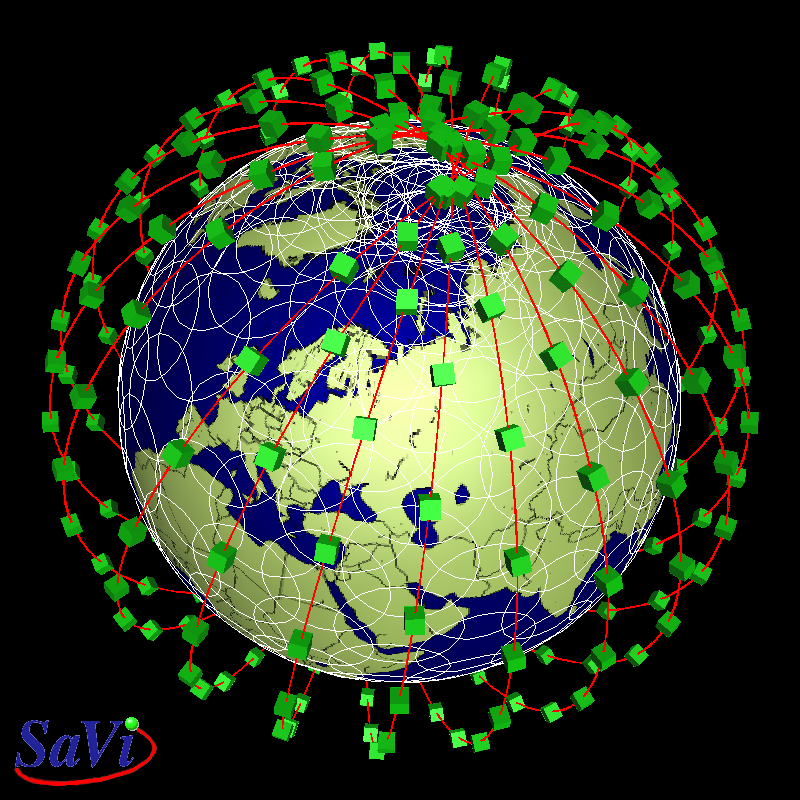
Simulation of the Teledesic satellite constellation (in the abbreviated version to 288 devices). It can be seen that with a uniform arrangement of the group in the circumpolar orbits with increasing latitude, multiple overlapping of the working zones of the satellites occurs. This is not as simple a problem as it seems, and requires either disconnecting some of the satellites from work at latitudes above 45, or having a lot of sophisticated equipment on board the satellite to reconfigure the work areas as the satellites approach poles.
Teledesic quickly got two rivals - the Iridium and Globalstar projects, which focused on the more familiar satellite telephony market, which was almost completely inaccessible to GSO operators (telephone communications directly from the geostationary required either a large antenna on the ground or an incredibly large antenna on satellite)
The Iridium project had a global coverage due to a constellation of 72 satellites (6x11 planes + a reserve of 1 satellite per plane) in 700 km orbits. Each satellite weighed 680 kg, but it had rather modest by today's standards capabilities for simultaneous work with ~ 1500 subscribers. The satellite orbits had an average altitude of 780 km for the LEO groupings.
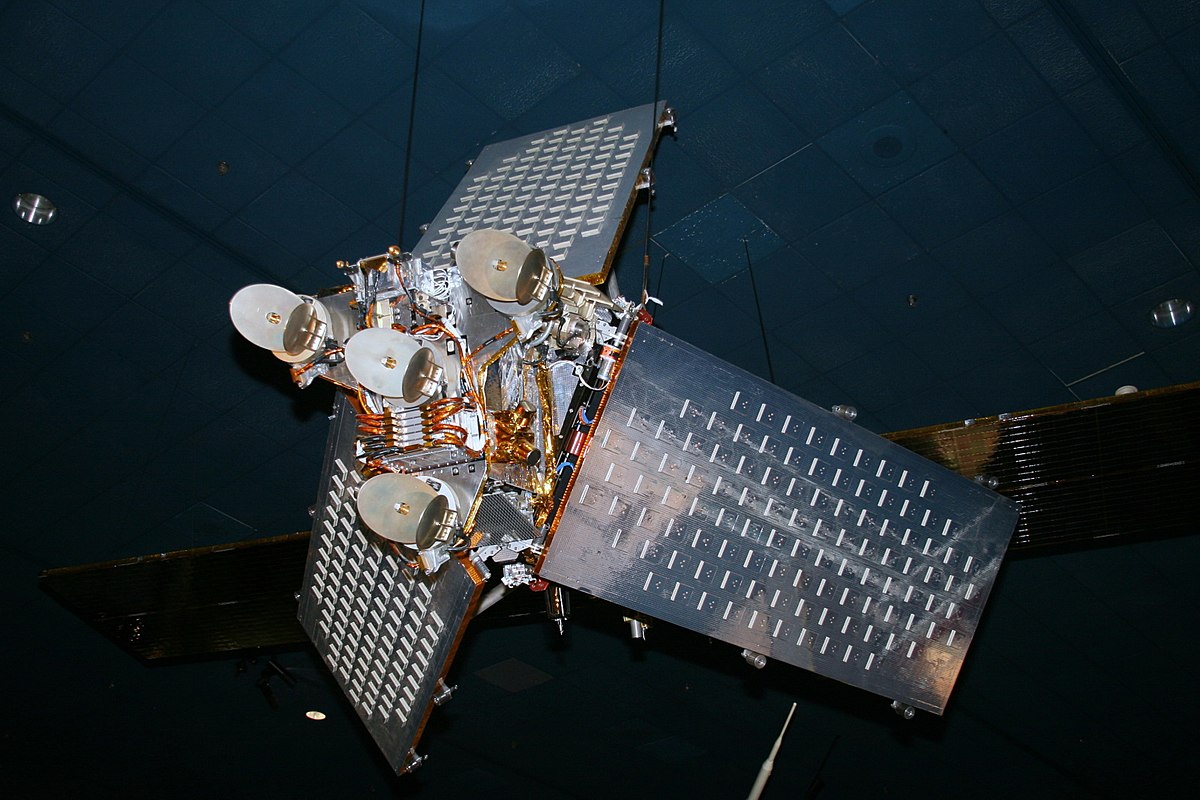
Satellite Iridium first generation. Three 48-beam subscriber antennas on the sides of the satellite gave us the phenomenon of " Iridium flares ". On the basis of the satellite, 5 Ka-band rotary antennas are visible, providing inter-satellite communication and communication with ground teleports.
The Iridium satellites had developed inter-satellite communications equipment, which made it possible to route calls to ground communication stations or a subscriber- satellite subscriber network. This equipment, in general, determined the weight of the satellites.
Almost immediately after the deployment of the group, the company went bankrupt, and only specialists would know about it now, if it were not for the Pentagon, who decided that the system is very useful for military purposes: the bankrupt Iridium was bought by Pentagon contractors who began to exploit the system for money from the military, writing off part of capital costs.
Iridium's competitor was Globalstar - a system deployed a year later, originally created according to more economical canons. There were only 48 satellites weighing 550 kg each, with an orbit height of 1,400 km, distributed over 6 pieces in 8 planes. Such a number of vehicles in such orbits did not allow covering the entire surface of the Earth, and the connection worked only up to ~ 70 latitude. However, Globastar could only work as a repeater from the subscriber to the ground gateway station, so there wouldn't be much use from it at the north pole.

Constellation «Globalstar». The decision to throw out the polar regions on the one hand saved a lot of money, on the other - deprived globalstar customers involved in work, research and travel near the poles - quite a significant part of all satellite telephony clients.
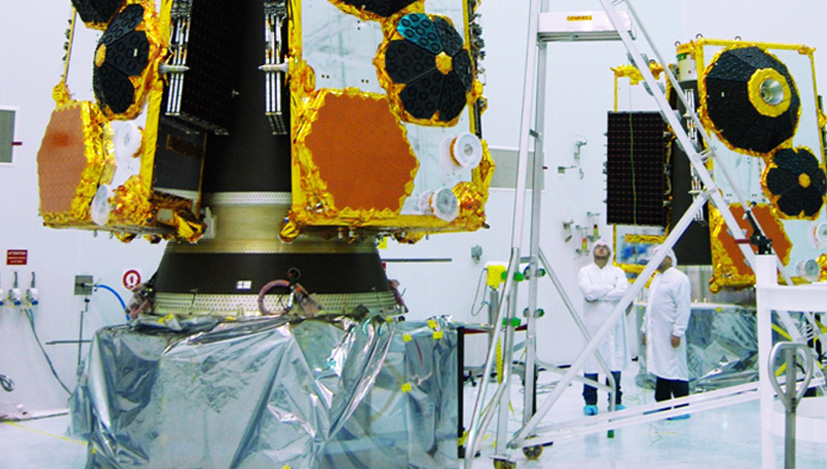
Globastar satellites are installed on the dispenser for launching into orbit. Strange black and orange pieces are receiving and transmitting antennas of the Subscriber-Satellite and Teleport-Satellite channels.
Such a less costly model allowed Globalstar to last longer, although eventually he went through bankruptcy.
Finally, in the 1990s, 2 more low-orbit (LEO) groups were created, probably little known - the domestic Gonets and the American Orbcomm. The “messenger” grew out of military-spy satellite systems and implied the ability to transmit small data packets or voice messages offline (i.e., satellites were used as flying mailboxes). In fact, this is a further simplification from Globastar, and to be honest, in my life I have never heard of using this system for commercial purposes.
Orbcomm essentially implemented the same approach of “satellites - offline mailboxes”, and in 1998 deployed 36 satellites to provide M2M services (data collection from remote equipment). Like all other companies, Orbcomm went through bankruptcy, but because of the initial minimal investment in the system (no land teleports, the lightest satellites, low requirements for continuity of coverage, etc), the company has straightened up and is still alive with the 3 other projects listed above.

The Orbcomm project was one of the first to take advantage of the reduction in the size of electronics and satellites in general, using devices weighing only 40 kg for operation.
Thus, the sad experience of the 1990s led to the conclusion that NOU communication groups are possible, but economically untenable. The next 10 years, investors have fled from new proposals on this subject, like devils from incense. However, all bad things are quickly forgotten, and now, by the beginning of 2010, the world saw a new surge of low-orbitals looking for investments.
This dawn is supported by some logical statements. First of all, the Internet from a funny non-commercial thing in the 1990s turned into one of the most powerful channels of consumption, and is in high demand everywhere, but there are still locations where ground operators did not reach their optics. Secondly, the development of both satellite and telecommunications equipment since the 1990s has gone quite far, and the task of creating a dynamic multipath working field “satellite-to-earth”, data routing, inter-satellite high-speed laser communication can now be solved in a 150-200 kg satellite, instead 1000 kg 20 years ago.
Finally, ground-based subscriber equipment is also quite advanced in its capabilities. In the 1990s, it was madness to offer subscribers equipment with AFAR (active phased antenna arrays), which would allow tracking the main beam of the receiving antenna satellites in the sky. There were no technologies allowing to produce such antennas for at least some reasonable money. Antennas with a two-step mechanical drive are also not cheap and not suitable for mass solutions, while the radio physics of broadband channels required antennas with good gain (that is, directional).
Today, satellite communications solutions that use AFAR with a dynamic beam are gradually penetrating the satellite communications market - for the time being mainly in providing Internet for ships and airplanes, and already in the near future, such antennas can become widespread.

AFAR antennas for the O3b system (about it below) installed on airplanes and ships. At the expense of GPS and MEMS-gyroscopes, the antenna knows its position in space and forms a beam of maximum amplification, directed exactly at the satellite to compensate for movement and rolls of the technology.
The first sign of the new development of telecommunications satellite groupings was the O3b project, which started in 2007. This project is not like the others, but not to mention it would be wrong. Launched at that moment when the pain of financial losses on Iridium and Globalstar has not yet been forgotten, the project was not focused on end users, but on the delivery of the Internet to a) cruise liners b) small islands c) airplanes - all this in a relatively equatorial zone, up to 45 latitude. A group of 8 satellites at the beginning and 16 in full configuration rotates in the same orbit at an altitude of 8100 km above the surface, i.e. approximately ¼ of height from the geostationary orbit. Each satellite has 12 antennas with two-degree control, and can create 10 client beams with a diameter of approximately 700 km and a capacity of 1.6 Gbit per beam. The remaining 2 antennas look at the points of interfacing with the global network (signalers call such points teleports).
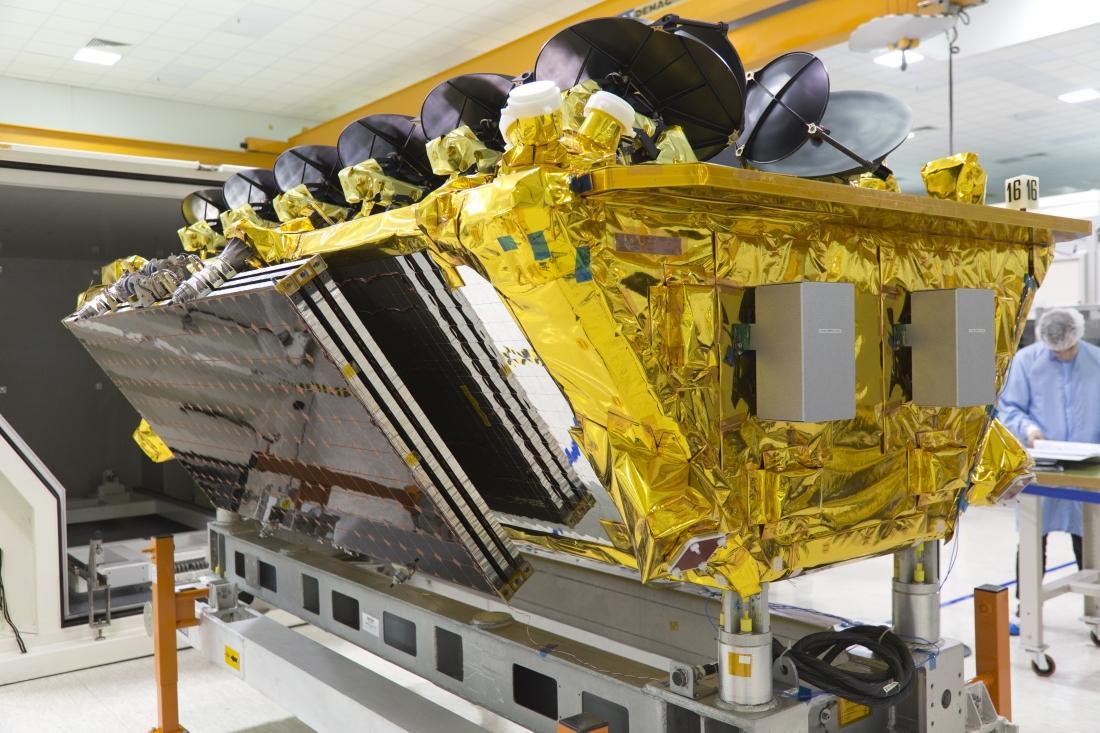
Satellite O3b weighing 700 kg.
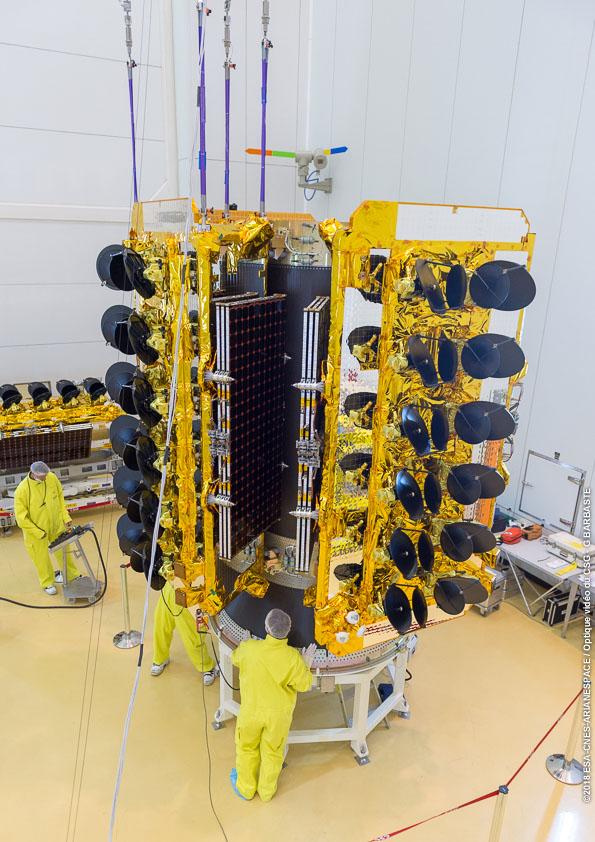
O3b satellites on the dispenser. One can see 12 sets of radio-optics with two-stage drives for organizing client beams.
The project successfully raised money for launch, and in March 2019 completed the deployment of a full group of 16 satellites, spending modest ~ 1.5 billion dollars to implement.

The principle of grouping O3b. Excellent niche solution, apparently.
Interestingly, the ideologist and creator of O3b was a man named Greg Wyler, who later launched a completely new satellite project that marked the beginning of the hyper-grouping boom. So, meet - a system of 1600 satellites “OneWeb”.
Founded by him in 2012 (under the name WorldVu), the company envisaged the withdrawal of more than 2,000 satellites (the number changes over time) into a low near-earth orbit. The number of required WordVu satellites is amazing - it is comparable to all other active satellites in Earth orbit.
And it's not just about the number as such. When you try to quickly assemble and launch 2000 satellites, an incredible amount of difficulties will arise. To date, satellites are collected as a Swiss watch - it is handmade jewelry with an incredible amount of control and “chips”, so that God forbid that we do not leave organic matter on the insulation or damage the electronics by static discharge. Cosmos is cruel. And so, it is proposed to convey not only the assembly of satellites, but also the multitude of necessary components of space quality (electronics, connectors, chemical and electric propulsion engines, etc).
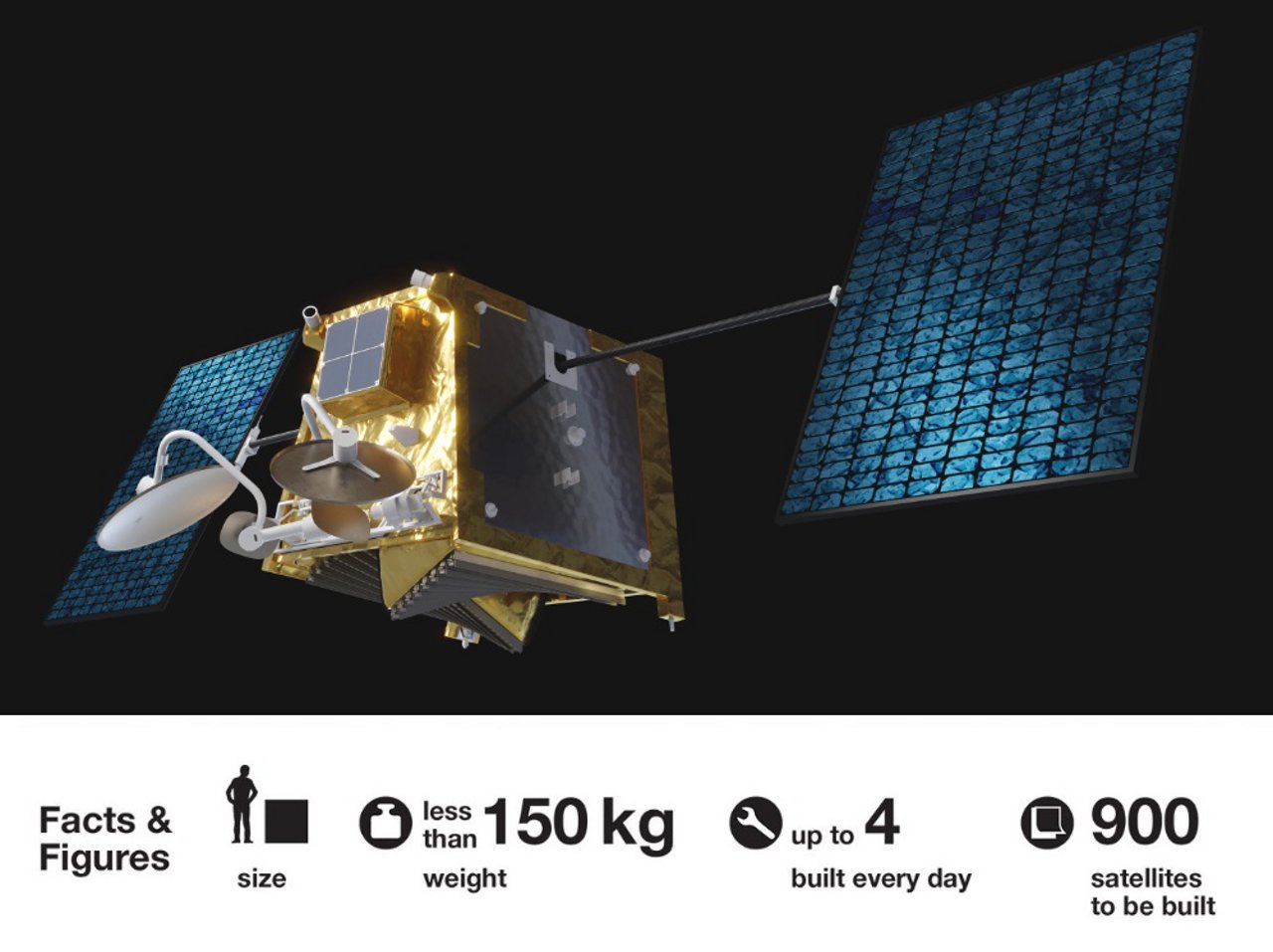
OneWeb satellite, the contract for the production of which was obtained by Airbus, implements the Teledesic capabilities with six times less weight and three times lower price.
However, such an ambitious plan has logic. Suppose you decide to create a system that distributes the Internet from just a hundred machines, and not 2000. Then you will encounter the fact that several million square kilometers will inevitably fall into the limited bandwidth of each. And if over the oceans with rare yachts, customers is just fine, then over densely populated countries - on the contrary. China, Europe, the whole of Southeast Asia will have 2 satellites in your 100-satellite system, and as many as 3 in South America. How many clients can such a group serve? Not. Is this enough for payback? Also no. It is necessary to increase the number of satellites. If you bring 2000-4000 satellites, and create a subscriber-satellite beam scheme that is comparable to the early GSM networks by the number of cells, business models grow together, and even, say, the suburbs in the American agglomerations are becoming suitable places to search for clientele.
The problem, however, is that financial models are fine, but the real profitability and relevance of these space projects can only be understood by expanding the network. And for deployment you need to spend many billions of dollars, and the more satellites are supposed to be in the full network, the more billions are needed.
OneWeb advertising video, including footage of the assembly of the first batch of satellites. While it cannot be said that the assembly technology is visible somewhere, although some of the operations are mechanized.
Now OneWeb (bought by the largest GSO operator Intelsat) is trying to go along the narrow path between the abysses of insufficient network bandwidth and too large initial investments for which it is impossible to find investors. And while this path looks difficult - not so long ago, the project decided to reduce the total number of deployed satellites to 1600, and the initial phase from 900 to 600 satellites. At the same time, the project will focus more on customers in the form of airplanes and ships (where many other satellite operators are already working), rather than on the mass of ordinary people. Alarming signs.
The first 6 OneWeb satellites were launched in February 2018 by the Soyuz-2.1B rocket from the Kourou space center. It seems that we will not see the full deployment of the system until 2021.
Nevertheless, the OneWeb project is still developing, raising money (all investors have already invested about $ 3 billion sufficient for the first 600 deployed satellites), and it has competitors: SpaceX Starlink and Amazon Kuiper hyper-group projects and Temseat LeoSat group projects. (LEO = low earth orbit, hence such a commitment to this word in the names).
SpaceX Starlink currently provides for the deployment of 1584 satellites at the initial stage and up to 12,000 (!!!) in full configuration. It is planned to use altitudes of 550 km (40 orbital planes of 66 vehicles), 330 km (here there will be the main mass of satellites of 7,500 units) and 1,150 km (about 3,000 devices). In terms of radio communication, it also provides for the use of multiple bands at once (including the weakly mastered components of the V band - 50+ GHz), but at the first stage, the traditional Ku (10-20 GHz) with a bandwidth of several gigabits per satellite. Provides inter-satellite laser communication at speeds of several hundred gigabits.

Starlink satellites are even more progressive than OneWeb, with innovative krypton electrojet engines, industrial electronics and orbital reserve support instead of reliability, etc. But today, far from all the details are still known.
In short, the Starlink project is incredibly ambitious and will have to fight for the client with land cable operators for payback. The project’s prospects are still vague (including the plan to collect the necessary funds for the deployment of the minimum operational grouping), but the deployment of 60 satellites at once in one launch (against 6 from OneWeb, I remind you) last week makes the heart beat faster.
Simulation of the Starlink orbital constellation after the launch of the first 264 satellites.
And the communication simulation via Starlink in a fully deployed group of 1,584 satellites.
Another equally ambitious player is Amazon, which has applied for the deployment of 3236 satellites in the framework of the Kuiper project. So far, little is known about the project, apart from the traditional words about “3 billion people not connected to the Internet” (as if the problem is technical difficulties, and not the lack of money for the 3 billion Internet). But at the very least a possible synergy is visible for one of the largest online stores in the world in transmitting traffic from a satellite constellation through itself. From here we can expect that the Kuiper project has more chances for implementation.
In addition to super-complex projects OneWeb, Starlink, Kuiper, there were a few more gestures from Boeing and Samsung, but these companies didn’t dare to venture into such risky investments.
Finally, briefly about a little less ambitious and a bit more niche Telesat Leo and LeoSat. Both of these projects are aimed at competing with terrestrial fiber optic highways. Their task is to take rather broadband traffic from a business client and carry it through the satellite constellation to a teleport somewhere in another part of the globe. Both projects involve the removal of ~ 110 satellites, while Telesat Leo elegantly solves the problem of excess satellite capacity at high latitude with a uniform filling of oblique orbits - by creating two types of grouping: ~ 45 degrees in orbits and polar orbits. Both of these projects are still engaged in collecting money, while the company Telesat (a large satellite operator of the GSO satellite) looks more promising.
Communication simulation through Telesat LEO
Summing up, I want to note that the new boom is still mostly pleased with the manufacturers of satellites and satellite components receiving incredible orders. Operators of launch services are also happy to wait for an incredible increase in orders (including Roskosmos, to which OneWeb ordered launch for 21 “Soyuz-2” in various forms). Will the new reality be able to gain a foothold with the transfer of communication networks into space? Who knows. However, if this happens, then humanity will clearly receive a noticeable boost in space exploration and reducing the cost of space technology production and payload output.

Satellite communications today and the last 30 years are primarily geostationary transponder satellites located, respectively, in a geostationary orbit, where the satellite is approximately fixed relative to a ground-based observer and is equivalent to a conventional radio repeater located on a 35,000-kilometer tower. At the same time, one single satellite is visible immediately from ~ 35% of the Earth’s area, and three are enough to cover the entire surface except the polar regions.
Geostationary communications satellites today are very heavy machines, weighing up to 4 tons (in working orbit) providing communication channels up to several hundred gigabits wide. This image of these satellites was formed, on the one hand, from a huge area of light by a radio signal from a satellite (how many radio towers can boast access to 5 billion potential customers?), And on the other hand - the weight of equipment that can squeeze the maximum bandwidth from an available radio spectrum.
')

Adjusting the antenna patterns of the geostationary satellite Eutelsat 8 West B. Pay attention to the “wrinkled” surfaces of the antenna reflectors - this is done specifically to form a contour pattern on Earth (hence the adjustment is required) and not to get into the outlines of other GSO satellites . Coordination of spatial-spectral characteristics is today a very difficult task in satellite projects, and low-orbit systems are no exception.
Pay attention to the words “available radio spectrum”. Satellite communications operate at frequencies from 1.5 to 60 gigahertz, however, in this very broad radio channel, there are not so many satellites available. Firstly, in the range from 1.5 to 10 GHz, many terrestrial consumers of the radio spectrum - a typical example - is wi-fi around central 2.4 and 5.5 GHz. Secondly, above 20 GHz, rain, hail, and cloudiness begin to affect the work of the radio channel. Thirdly, the available band has to be divided by at least two in order to organize the Earth-to-Satellite channel. As a result, the actively used satellite communications ranges (denoted by the letters S, C, Ku, Ka) are just 6 GHz of band, for which there is a deadly battle of many operators.
Initially, however, 6 GHz was quite enough. After all, 15 years ago, the main content that was delivered to subscribers of communications satellites was television, and the same radio signal could deliver TV content to tens of millions of subscribers at once. However, with the advent of 2000s, the market began to roll more and more toward digital two-way communication, where the need for bandwidth grows linearly with the number of subscribers.

Build a navigation satellite Galileo. In fact, the assembly of modern satellites is reduced to the manual installation of the components of the satellite systems on the power panels and the manual tracing of dozens of cables and pipelines that connect them, as well as to the large volume of functional tests of the resulting complex. In this regard, satellites are more like precision industrial equipment than, say, aircraft.
GSO satellites responded to the change in the market by spatial reuse of frequencies - the satellite emits a plurality of relatively narrow rays that come across the same frequencies (according to the principle of cellular networks). But this shift in needs has also shifted the optimality of the GSO machines towards other solutions.
From the high-flying GSO satellites we move on to the low-orbit satellite. The idea is to replace one heavy quasi-fixed satellite with a swarm of flying in a low orbit. The idea is rather obvious, but not used until the 90s, due to the balance of pro and contra.
What are the advantages of low-orbiting satellites in front of GSO satellites?
- Low orbit is much lower ... yes. In fact, this gives a very significant reduction in energy loss in the radio channel (up to 4 orders of magnitude), which allows the use of small antennas and low-power transmitters, both on the ground and on the satellite
- A low orbit also means a low signal delay - the pause in the interlocutor’s responses during telephony via GSO is quite noticeable (ping 250 ms one way)
- The “many satellites” structure allows you to reuse the frequency resource on each (slightly simplifying the situation), and to obtain a theoretically much larger total bandwidth on the same spectrum and serve much more subscribers.
But the advantages are not limited to one thing, of course:
- A low-orbit system implies maintaining a large satellite constellation in operation, a multitude of ground interfacing stations with communication networks - in general, the capital expenditures for deployment are much greater.
- The satellites move over the heads of subscribers, which means that you need to use either omnidirectional antennas or highly advanced tracking systems, which almost completely eliminates the advantage of good energy
- Extremely sophisticated satellites with advanced antenna systems, high-speed digital switches, high-speed inter-satellite tracking and tracking systems are needed to provide in reality, rather than on paper, a large system bandwidth with multiple reuse of the spectrum - in the early 1990s nothing existed in finished form.
Despite the unobvious balance of advantages and disadvantages, several operators rushed to implement the new idea of satellite communications in the 1990s. The most famous project of that time was called Teledesic and meant 840 vehicles in a 700 km orbit with the task of delivering the Internet to land subscribers. Teledesic collected about a billion dollars, but did not succeed. From the time the project was conceived in 1990 to the launch of the first experimental satellite in 1998, the ground operators managed to win back a significant part of the market that Teledesic aimed at; financial models showed a non-payback of 9 billion dollars (about 20 billion in today's dollars), so the project was bankrupt without reaching before deployment.

Simulation of the Teledesic satellite constellation (in the abbreviated version to 288 devices). It can be seen that with a uniform arrangement of the group in the circumpolar orbits with increasing latitude, multiple overlapping of the working zones of the satellites occurs. This is not as simple a problem as it seems, and requires either disconnecting some of the satellites from work at latitudes above 45, or having a lot of sophisticated equipment on board the satellite to reconfigure the work areas as the satellites approach poles.
Teledesic quickly got two rivals - the Iridium and Globalstar projects, which focused on the more familiar satellite telephony market, which was almost completely inaccessible to GSO operators (telephone communications directly from the geostationary required either a large antenna on the ground or an incredibly large antenna on satellite)
The Iridium project had a global coverage due to a constellation of 72 satellites (6x11 planes + a reserve of 1 satellite per plane) in 700 km orbits. Each satellite weighed 680 kg, but it had rather modest by today's standards capabilities for simultaneous work with ~ 1500 subscribers. The satellite orbits had an average altitude of 780 km for the LEO groupings.

Satellite Iridium first generation. Three 48-beam subscriber antennas on the sides of the satellite gave us the phenomenon of " Iridium flares ". On the basis of the satellite, 5 Ka-band rotary antennas are visible, providing inter-satellite communication and communication with ground teleports.
The Iridium satellites had developed inter-satellite communications equipment, which made it possible to route calls to ground communication stations or a subscriber- satellite subscriber network. This equipment, in general, determined the weight of the satellites.
Almost immediately after the deployment of the group, the company went bankrupt, and only specialists would know about it now, if it were not for the Pentagon, who decided that the system is very useful for military purposes: the bankrupt Iridium was bought by Pentagon contractors who began to exploit the system for money from the military, writing off part of capital costs.
Iridium's competitor was Globalstar - a system deployed a year later, originally created according to more economical canons. There were only 48 satellites weighing 550 kg each, with an orbit height of 1,400 km, distributed over 6 pieces in 8 planes. Such a number of vehicles in such orbits did not allow covering the entire surface of the Earth, and the connection worked only up to ~ 70 latitude. However, Globastar could only work as a repeater from the subscriber to the ground gateway station, so there wouldn't be much use from it at the north pole.

Constellation «Globalstar». The decision to throw out the polar regions on the one hand saved a lot of money, on the other - deprived globalstar customers involved in work, research and travel near the poles - quite a significant part of all satellite telephony clients.

Globastar satellites are installed on the dispenser for launching into orbit. Strange black and orange pieces are receiving and transmitting antennas of the Subscriber-Satellite and Teleport-Satellite channels.
Such a less costly model allowed Globalstar to last longer, although eventually he went through bankruptcy.
Finally, in the 1990s, 2 more low-orbit (LEO) groups were created, probably little known - the domestic Gonets and the American Orbcomm. The “messenger” grew out of military-spy satellite systems and implied the ability to transmit small data packets or voice messages offline (i.e., satellites were used as flying mailboxes). In fact, this is a further simplification from Globastar, and to be honest, in my life I have never heard of using this system for commercial purposes.
Orbcomm essentially implemented the same approach of “satellites - offline mailboxes”, and in 1998 deployed 36 satellites to provide M2M services (data collection from remote equipment). Like all other companies, Orbcomm went through bankruptcy, but because of the initial minimal investment in the system (no land teleports, the lightest satellites, low requirements for continuity of coverage, etc), the company has straightened up and is still alive with the 3 other projects listed above.

The Orbcomm project was one of the first to take advantage of the reduction in the size of electronics and satellites in general, using devices weighing only 40 kg for operation.
Thus, the sad experience of the 1990s led to the conclusion that NOU communication groups are possible, but economically untenable. The next 10 years, investors have fled from new proposals on this subject, like devils from incense. However, all bad things are quickly forgotten, and now, by the beginning of 2010, the world saw a new surge of low-orbitals looking for investments.
This dawn is supported by some logical statements. First of all, the Internet from a funny non-commercial thing in the 1990s turned into one of the most powerful channels of consumption, and is in high demand everywhere, but there are still locations where ground operators did not reach their optics. Secondly, the development of both satellite and telecommunications equipment since the 1990s has gone quite far, and the task of creating a dynamic multipath working field “satellite-to-earth”, data routing, inter-satellite high-speed laser communication can now be solved in a 150-200 kg satellite, instead 1000 kg 20 years ago.
Finally, ground-based subscriber equipment is also quite advanced in its capabilities. In the 1990s, it was madness to offer subscribers equipment with AFAR (active phased antenna arrays), which would allow tracking the main beam of the receiving antenna satellites in the sky. There were no technologies allowing to produce such antennas for at least some reasonable money. Antennas with a two-step mechanical drive are also not cheap and not suitable for mass solutions, while the radio physics of broadband channels required antennas with good gain (that is, directional).
Today, satellite communications solutions that use AFAR with a dynamic beam are gradually penetrating the satellite communications market - for the time being mainly in providing Internet for ships and airplanes, and already in the near future, such antennas can become widespread.

AFAR antennas for the O3b system (about it below) installed on airplanes and ships. At the expense of GPS and MEMS-gyroscopes, the antenna knows its position in space and forms a beam of maximum amplification, directed exactly at the satellite to compensate for movement and rolls of the technology.
The first sign of the new development of telecommunications satellite groupings was the O3b project, which started in 2007. This project is not like the others, but not to mention it would be wrong. Launched at that moment when the pain of financial losses on Iridium and Globalstar has not yet been forgotten, the project was not focused on end users, but on the delivery of the Internet to a) cruise liners b) small islands c) airplanes - all this in a relatively equatorial zone, up to 45 latitude. A group of 8 satellites at the beginning and 16 in full configuration rotates in the same orbit at an altitude of 8100 km above the surface, i.e. approximately ¼ of height from the geostationary orbit. Each satellite has 12 antennas with two-degree control, and can create 10 client beams with a diameter of approximately 700 km and a capacity of 1.6 Gbit per beam. The remaining 2 antennas look at the points of interfacing with the global network (signalers call such points teleports).

Satellite O3b weighing 700 kg.

O3b satellites on the dispenser. One can see 12 sets of radio-optics with two-stage drives for organizing client beams.
The project successfully raised money for launch, and in March 2019 completed the deployment of a full group of 16 satellites, spending modest ~ 1.5 billion dollars to implement.

The principle of grouping O3b. Excellent niche solution, apparently.
Interestingly, the ideologist and creator of O3b was a man named Greg Wyler, who later launched a completely new satellite project that marked the beginning of the hyper-grouping boom. So, meet - a system of 1600 satellites “OneWeb”.
Founded by him in 2012 (under the name WorldVu), the company envisaged the withdrawal of more than 2,000 satellites (the number changes over time) into a low near-earth orbit. The number of required WordVu satellites is amazing - it is comparable to all other active satellites in Earth orbit.
And it's not just about the number as such. When you try to quickly assemble and launch 2000 satellites, an incredible amount of difficulties will arise. To date, satellites are collected as a Swiss watch - it is handmade jewelry with an incredible amount of control and “chips”, so that God forbid that we do not leave organic matter on the insulation or damage the electronics by static discharge. Cosmos is cruel. And so, it is proposed to convey not only the assembly of satellites, but also the multitude of necessary components of space quality (electronics, connectors, chemical and electric propulsion engines, etc).

OneWeb satellite, the contract for the production of which was obtained by Airbus, implements the Teledesic capabilities with six times less weight and three times lower price.
However, such an ambitious plan has logic. Suppose you decide to create a system that distributes the Internet from just a hundred machines, and not 2000. Then you will encounter the fact that several million square kilometers will inevitably fall into the limited bandwidth of each. And if over the oceans with rare yachts, customers is just fine, then over densely populated countries - on the contrary. China, Europe, the whole of Southeast Asia will have 2 satellites in your 100-satellite system, and as many as 3 in South America. How many clients can such a group serve? Not. Is this enough for payback? Also no. It is necessary to increase the number of satellites. If you bring 2000-4000 satellites, and create a subscriber-satellite beam scheme that is comparable to the early GSM networks by the number of cells, business models grow together, and even, say, the suburbs in the American agglomerations are becoming suitable places to search for clientele.
The problem, however, is that financial models are fine, but the real profitability and relevance of these space projects can only be understood by expanding the network. And for deployment you need to spend many billions of dollars, and the more satellites are supposed to be in the full network, the more billions are needed.
OneWeb advertising video, including footage of the assembly of the first batch of satellites. While it cannot be said that the assembly technology is visible somewhere, although some of the operations are mechanized.
Now OneWeb (bought by the largest GSO operator Intelsat) is trying to go along the narrow path between the abysses of insufficient network bandwidth and too large initial investments for which it is impossible to find investors. And while this path looks difficult - not so long ago, the project decided to reduce the total number of deployed satellites to 1600, and the initial phase from 900 to 600 satellites. At the same time, the project will focus more on customers in the form of airplanes and ships (where many other satellite operators are already working), rather than on the mass of ordinary people. Alarming signs.
The first 6 OneWeb satellites were launched in February 2018 by the Soyuz-2.1B rocket from the Kourou space center. It seems that we will not see the full deployment of the system until 2021.
Nevertheless, the OneWeb project is still developing, raising money (all investors have already invested about $ 3 billion sufficient for the first 600 deployed satellites), and it has competitors: SpaceX Starlink and Amazon Kuiper hyper-group projects and Temseat LeoSat group projects. (LEO = low earth orbit, hence such a commitment to this word in the names).
SpaceX Starlink currently provides for the deployment of 1584 satellites at the initial stage and up to 12,000 (!!!) in full configuration. It is planned to use altitudes of 550 km (40 orbital planes of 66 vehicles), 330 km (here there will be the main mass of satellites of 7,500 units) and 1,150 km (about 3,000 devices). In terms of radio communication, it also provides for the use of multiple bands at once (including the weakly mastered components of the V band - 50+ GHz), but at the first stage, the traditional Ku (10-20 GHz) with a bandwidth of several gigabits per satellite. Provides inter-satellite laser communication at speeds of several hundred gigabits.

Starlink satellites are even more progressive than OneWeb, with innovative krypton electrojet engines, industrial electronics and orbital reserve support instead of reliability, etc. But today, far from all the details are still known.
In short, the Starlink project is incredibly ambitious and will have to fight for the client with land cable operators for payback. The project’s prospects are still vague (including the plan to collect the necessary funds for the deployment of the minimum operational grouping), but the deployment of 60 satellites at once in one launch (against 6 from OneWeb, I remind you) last week makes the heart beat faster.
Simulation of the Starlink orbital constellation after the launch of the first 264 satellites.
And the communication simulation via Starlink in a fully deployed group of 1,584 satellites.
Another equally ambitious player is Amazon, which has applied for the deployment of 3236 satellites in the framework of the Kuiper project. So far, little is known about the project, apart from the traditional words about “3 billion people not connected to the Internet” (as if the problem is technical difficulties, and not the lack of money for the 3 billion Internet). But at the very least a possible synergy is visible for one of the largest online stores in the world in transmitting traffic from a satellite constellation through itself. From here we can expect that the Kuiper project has more chances for implementation.
In addition to super-complex projects OneWeb, Starlink, Kuiper, there were a few more gestures from Boeing and Samsung, but these companies didn’t dare to venture into such risky investments.
Finally, briefly about a little less ambitious and a bit more niche Telesat Leo and LeoSat. Both of these projects are aimed at competing with terrestrial fiber optic highways. Their task is to take rather broadband traffic from a business client and carry it through the satellite constellation to a teleport somewhere in another part of the globe. Both projects involve the removal of ~ 110 satellites, while Telesat Leo elegantly solves the problem of excess satellite capacity at high latitude with a uniform filling of oblique orbits - by creating two types of grouping: ~ 45 degrees in orbits and polar orbits. Both of these projects are still engaged in collecting money, while the company Telesat (a large satellite operator of the GSO satellite) looks more promising.
Communication simulation through Telesat LEO
Summing up, I want to note that the new boom is still mostly pleased with the manufacturers of satellites and satellite components receiving incredible orders. Operators of launch services are also happy to wait for an incredible increase in orders (including Roskosmos, to which OneWeb ordered launch for 21 “Soyuz-2” in various forms). Will the new reality be able to gain a foothold with the transfer of communication networks into space? Who knows. However, if this happens, then humanity will clearly receive a noticeable boost in space exploration and reducing the cost of space technology production and payload output.
Source: https://habr.com/ru/post/453728/
All Articles